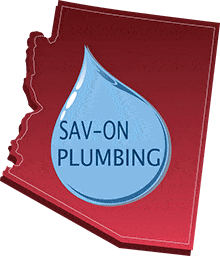People experiencing drain problems call us frequently. Two of the more common drains they have trouble with are the washing machine drain and the shower drain. Local building authorities require today’s builders to use two-inch diameter pipe and fittings on washing machine drains. Years ago, that wasn’t the case. As you can see from this picture, many washing machine drains in older homes were only one-and-one-half diameter pipe. While they may have worked for older machines, today’s larger capacity machines and high-output pumps frequently overwhelm the capability of smaller diameter drains.
Sometimes you can clean the drain and it will function properly for a short time. Then, debris such as lint builds up and the drain overflows again. If they have the room, many customers install a slop sink to allow the washing machine to empty into it. If there is no room for this solution, then you can resolve your backup problems by changing the drain to the properly-sized, two-inch drain. In most cases, this requires the services of a professional plumber.
Shower drains frequently cause problems. This picture is a p-trap, corroded beyond recognition, which came out from under a bath tub. This is a 1960s to early 1970s cast iron drain from under the concrete floor in a bathroom. Note how full of corrosion and sludge it is. When a drain gets to this condition, cleaning the drain is a very temporary fix, at best. Then add in the mess that chemical drain “cleaners” provide, and replacement becomes the only option. This customer was lucky because we were able to remove and replace the p-trap without removing the bath tub.
At Sav-On Plumbing, we are skilled at these types of repair. We will provide this service at your convenience, even if it means on a Saturday. Preventative maintenance can save hundreds of dollars in repair. Contact us at (602) 488-4647 for a no-obligation estimate to avoid a potentially costly water backup.


